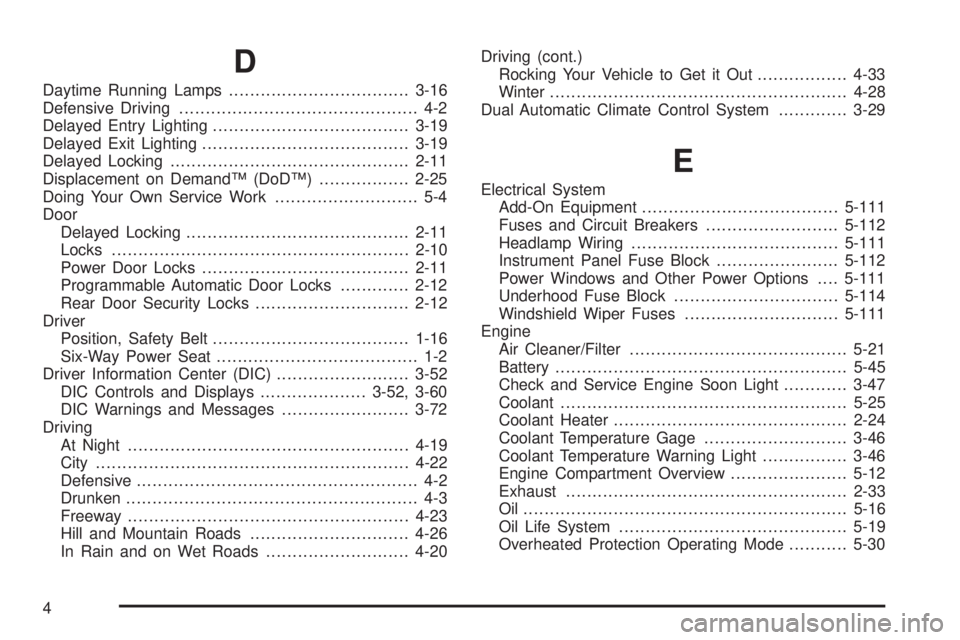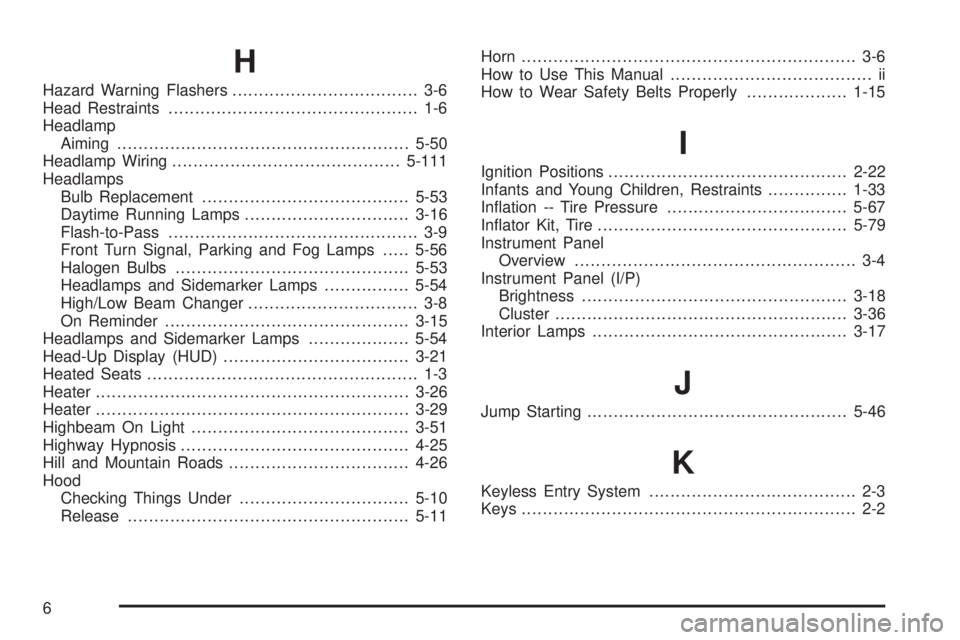2006 PONTIAC GRAND PRIX wiring
[x] Cancel search: wiringPage 87 of 472

When you want to open a rear door when the security
lock is on, do the following:
1. Unlock the door using the remote keyless entry
transmitter, if equipped, the power door lock
switch, or by lifting the rear door manual lock.
2. Open the door from the outside.
To cancel the rear door security lock, do the following:
1. Unlock the door and open it from the outside.
2. Insert the key into the security lock slot and turn it
so the slot is in the vertical position.
Lockout Protection
The lockout protection feature makes it more difficult to
lock the key in the vehicle. If the driver’s door is
open while the key is in the ignition, the door cannot be
locked with the power door lock switch.
This feature cannot guarantee that you will never be
locked out of the vehicle. If the key is not left in
the ignition, or, if the manual door lock pin is used, the
key could still be locked inside the vehicle. Always
remember to take the key with you.
Trunk
{CAUTION:
It can be dangerous to drive with the trunk lid
open because carbon monoxide (CO) gas can
come into your vehicle. You cannot see or
smell CO. It can cause unconsciousness and
even death. If you must drive with the trunk lid
open or if electrical wiring or other cable
connections must pass through the seal
between the body and the trunk lid:
Make sure all other windows are shut.
Turn the fan on your heating or cooling
system to its highest speed and select the
control setting that will force outside air
into your vehicle. See Climate Control
System.
If you have air outlets on or under the
instrument panel, open them all the way.
SeeEngine Exhaust on page 2-33.
To unlock and open the trunk from the outside, press the
trunk button on the remote keyless entry transmitter. See
Remote Keyless Entry System Operation on page 2-4.
2-13
Page 157 of 472

Airbag Readiness Light
There is an airbag readiness light on the instrument
panel, which shows the airbag symbol. The system
checks the airbag’s electrical system for malfunctions.
The light indicates if there is an electrical problem.
The system check includes the airbag sensors,
the airbag modules, the wiring, and the diagnostic
module. For more information on the airbag system, see
Airbag System on page 1-52.
This light will come on
when the vehicle is
started, and it will �ash for
a few seconds. Then
the light should go out.
This means the system is
functioning properly.
If the airbag readiness light stays on after the vehicle is
started, or comes on as the vehicle is being driven,
the airbag system may not work properly. Have
the vehicle serviced right away.{CAUTION:
If the airbag readiness light stays on after you
start your vehicle, it means the airbag system
may not be working properly. The airbags in
your vehicle may not in�ate in a crash, or they
could even in�ate without a crash. To help avoid
injury to yourself or others, have your vehicle
serviced right away if the airbag readiness light
stays on after you start your vehicle.
The airbag readiness light should �ash for a few
seconds when the ignition key is turned to RUN. If the
light does not come on then, have it �xed so it will
be ready to warn you if there is a problem.
3-39
Page 304 of 472

Before starting, check the trailer hitch and platform (and
attachments), safety chains, electrical connector,
lamps, tires, and mirror adjustment. If the trailer has
electric brakes, start the vehicle and trailer moving and
then apply the trailer brake controller by hand to be
sure the brakes are working. This lets you check
the electrical connection at the same time.
During your trip, check occasionally to be sure that the
load is secure, and that the lamps and any trailer
brakes are still working.
Following Distance
Stay at least twice as far behind the vehicle ahead as
when driving the vehicle without a trailer. This can
prevent situations that require heavy braking and
sudden turns.
Passing
More passing distance is needed up ahead when
towing a trailer. And, because the vehicle and trailer are
a good deal longer, distances between any vehicles
that are passed must be greater, before returning to
the proper lane.
Backing Up
Hold the bottom of the steering wheel with one hand.
Then, to move the trailer to the left, move that hand
to the left. To move the trailer to the right, move that
hand to the right. Always back up slowly and, if possible,
have someone guide you.
Making Turns
Notice:Making very sharp turns while trailering
could cause the trailer to come in contact with the
vehicle. Your vehicle could be damaged. Avoid
making very sharp turns while trailering.
When turning with a trailer, make wider turns than
normal. Do this so the trailer will not strike soft
shoulders, curbs, road signs, trees, or other objects.
Avoid jerky or sudden maneuvers. Signal well
in advance.
Turn Signals When Towing a Trailer
When towing a trailer, the vehicle may need a different
turn signal �asher and/or extra wiring. Check with
your dealer. The arrows on the instrument panel will
�ash whenever signaling a turn or lane change. Properly
hooked up, the trailer lamps will also �ash, telling
other drivers the vehicle and trailer are about to turn,
change lanes, or stop.
4-44
Page 308 of 472

When It Is Time for New Tires.......................5-71
Buying New Tires.........................................5-72
Different Size Tires and Wheels......................5-73
Uniform Tire Quality Grading..........................5-74
Wheel Alignment and Tire Balance..................5-75
Wheel Replacement......................................5-75
Tire Chains..................................................5-77
If a Tire Goes Flat........................................5-77
Tire In�ator Kit (GXP)....................................5-79
Changing a Flat Tire.....................................5-88
Removing the Spare Tire and Tools................5-90
Removing the Flat Tire and Installing
the Spare Tire..........................................5-91
Storing a Flat or Spare Tire and Tools............5-97
Compact Spare Tire......................................5-99
Appearance Care............................................5-99
Cleaning the Inside of Your Vehicle.................5-99
Fabric/Carpet..............................................5-101
Leather......................................................5-103
Ultra Lux Suede..........................................5-103
Instrument Panel, Vinyl, and Other
Plastic Surfaces.......................................5-104
Care of Safety Belts....................................5-104
Weatherstrips.............................................5-104Washing Your Vehicle..................................5-105
Cleaning Exterior Lamps/Lenses....................5-105
Finish Care................................................5-105
Windshield and Wiper Blades.......................5-106
Aluminum Wheels.......................................5-106
Tires.........................................................5-107
Sheet Metal Damage...................................5-107
Finish Damage...........................................5-107
Underbody Maintenance...............................5-108
Chemical Paint Spotting...............................5-108
Vehicle Care/Appearance Materials................5-109
Vehicle Identi�cation.....................................5-110
Vehicle Identi�cation Number (VIN)................5-110
Service Parts Identi�cation Label...................5-110
Electrical System..........................................5-111
Add-On Electrical Equipment.........................5-111
Headlamp Wiring........................................5-111
Windshield Wiper Fuses...............................5-111
Power Windows and Other Power Options......5-111
Fuses and Circuit Breakers..........................5-112
Instrument Panel Fuse Block........................5-112
Underhood Fuse Block................................5-114
Capacities and Speci�cations........................5-118
Section 5 Service and Appearance Care
5-2
Page 417 of 472

Electrical System
Add-On Electrical Equipment
Notice:Don’t add anything electrical to your vehicle
unless you check with your dealer �rst. Some
electrical equipment can damage your vehicle and
the damage wouldn’t be covered by your warranty.
Some add-on electrical equipment can keep other
components from working as they should.
Your vehicle has an airbag system. Before attempting to
add anything electrical to your vehicle, seeServicing
Your Airbag-Equipped Vehicle on page 1-65.
Headlamp Wiring
The headlamp circuit is protected by individual fuses in
the underhood fuse block. An electrical overload will
cause the fuse to blow. If this happens, have the
headlamp system checked right away.
Windshield Wiper Fuses
The windshield wiper motor is protected by a circuit
breaker and a fuse. If the motor overheats due to heavy
snow, etc., the wiper will stop until the motor cools. If
the overload is caused by some electrical problem, have
it �xed.
Power Windows and Other Power
Options
Circuit breakers in the fuse panel protect the power
windows and other power accessories. When the current
load is too heavy, the circuit breaker opens and
closes, protecting the circuit until the problem is �xed.
5-111
Page 418 of 472

Fuses and Circuit Breakers
The wiring circuits in the vehicle are protected from
short circuits by a combination of fuses, circuit breakers
and fusible thermal links in the wiring itself. This
greatly reduces the chance of �res caused by electrical
problems.
Look at the silver-colored band inside the fuse. If the
band is broken or melted, replace the fuse. Be sure to
replace a bad fuse with a new one of the identical
size and rating. Spare fuses and a fuse puller are
located in the underhood fuse block. SeeUnderhood
Fuse Blocklater in this section.
Instrument Panel Fuse Block
Some fuses are in a fuse
block located on the end
of the instrument panel on
the passenger side.
To get to the fuse block lift up on the side panel. A fuse
usage chart is on the inside of this panel.
5-112
Page 462 of 472

D
Daytime Running Lamps..................................3-16
Defensive Driving............................................. 4-2
Delayed Entry Lighting.....................................3-19
Delayed Exit Lighting.......................................3-19
Delayed Locking.............................................2-11
Displacement on Demand™ (DoD™).................2-25
Doing Your Own Service Work........................... 5-4
Door
Delayed Locking..........................................2-11
Locks........................................................2-10
Power Door Locks.......................................2-11
Programmable Automatic Door Locks.............2-12
Rear Door Security Locks.............................2-12
Driver
Position, Safety Belt.....................................1-16
Six-Way Power Seat...................................... 1-2
Driver Information Center (DIC).........................3-52
DIC Controls and Displays....................3-52, 3-60
DIC Warnings and Messages........................3-72
Driving
At Night.....................................................4-19
City...........................................................4-22
Defensive..................................................... 4-2
Drunken....................................................... 4-3
Freeway.....................................................4-23
Hill and Mountain Roads..............................4-26
In Rain and on Wet Roads...........................4-20Driving (cont.)
Rocking Your Vehicle to Get it Out.................4-33
Winter........................................................4-28
Dual Automatic Climate Control System.............3-29
E
Electrical System
Add-On Equipment.....................................5-111
Fuses and Circuit Breakers.........................5-112
Headlamp Wiring.......................................5-111
Instrument Panel Fuse Block.......................5-112
Power Windows and Other Power Options....5-111
Underhood Fuse Block...............................5-114
Windshield Wiper Fuses.............................5-111
Engine
Air Cleaner/Filter.........................................5-21
Battery.......................................................5-45
Check and Service Engine Soon Light............3-47
Coolant......................................................5-25
Coolant Heater............................................2-24
Coolant Temperature Gage...........................3-46
Coolant Temperature Warning Light................3-46
Engine Compartment Overview......................5-12
Exhaust.....................................................2-33
Oil .............................................................5-16
Oil Life System...........................................5-19
Overheated Protection Operating Mode...........5-30
4
Page 464 of 472

H
Hazard Warning Flashers................................... 3-6
Head Restraints............................................... 1-6
Headlamp
Aiming.......................................................5-50
Headlamp Wiring...........................................5-111
Headlamps
Bulb Replacement.......................................5-53
Daytime Running Lamps...............................3-16
Flash-to-Pass............................................... 3-9
Front Turn Signal, Parking and Fog Lamps.....5-56
Halogen Bulbs............................................5-53
Headlamps and Sidemarker Lamps................5-54
High/Low Beam Changer................................ 3-8
On Reminder..............................................3-15
Headlamps and Sidemarker Lamps...................5-54
Head-Up Display (HUD)...................................3-21
Heated Seats................................................... 1-3
Heater...........................................................3-26
Heater...........................................................3-29
Highbeam On Light.........................................3-51
Highway Hypnosis...........................................4-25
Hill and Mountain Roads..................................4-26
Hood
Checking Things Under................................5-10
Release.....................................................5-11Horn............................................................... 3-6
How to Use This Manual...................................... ii
How to Wear Safety Belts Properly...................1-15
I
Ignition Positions.............................................2-22
Infants and Young Children, Restraints...............1-33
In�ation -- Tire Pressure..................................5-67
In�ator Kit, Tire...............................................5-79
Instrument Panel
Overview..................................................... 3-4
Instrument Panel (I/P)
Brightness..................................................3-18
Cluster.......................................................3-36
Interior Lamps................................................3-17
J
Jump Starting.................................................5-46
K
Keyless Entry System....................................... 2-3
Keys............................................................... 2-2
6